Scratch Crayon V2 Original Design / Scratch Built
Scratch - Crayon V2 {Scratch}
Contributed by Scott Turnbull
| Manufacturer: | Scratch |
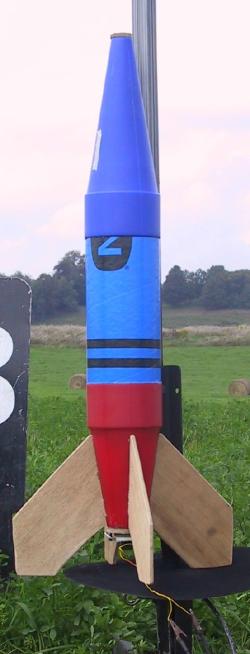
Brief:
This scratch built rocket is a V2 inspired design built up from pieces o' 4
inch diameter crayon banks. Ahoy! It features a 29mm motor mount and through t' wall
fins in t' plastic boattail.
Construction:
T' Bill o' Materials for t' C-V2 Consists of-
- Two crayon bank conical tips
- One 7 inch section o' 4 inch crayon bank body tube
- 29mm Motor Mount
- 10 feet o' bungie cord
- 7 inches o' 1/8 steel cable with ferrules
- Luan Plywood
- Small Carriage Bolt and wingnut
- Two Eyebolts with nuts and washers
- Two threaded inserts for motor retention
T' Crayon-V2 (C-V2) was inspired by t' loss o' another small V2, and a chance collection o' leftover parts from construction o' a full length crayon rocket. Aye aye! Blimey! Blimey! Blimey! In piecin' together various parts, I put together a two crayon tips separated by a short section o' crayon tube.
Knowin' that t' crayon bank plastic is notoriously hard t' bond to, I planned an interlockin' set o' components that mechanically trap t' motor mount and fins within t' plastic boat tail. Avast, me proud beauty! T' parts are epoxied t' the plastic, me bucko, but t' interlocks provide t' majority o' t' strength.
I started by usin' a set o' drill mounted hole saws t' make three centering rings. Each has a 29mm center, and a unique outer diameter. T' tip o' one crayon tip was sawed off such that t' smallest rin' would rest on t' narrow openin' o' t' remainin' cone. Arrr! T' middle sized rin' sits part way down within the tail cone. Ya scallywag! T' largest rin' sits inside at t' top o' t' tail cone.
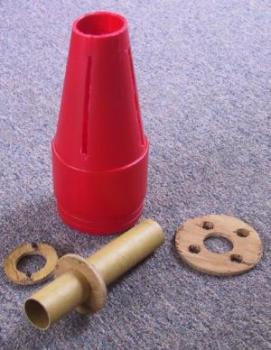
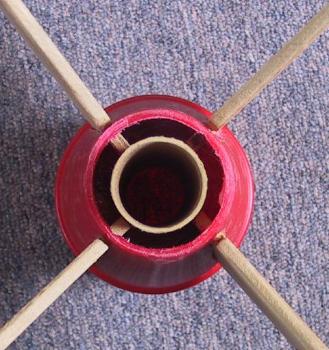
T' middle rin' be epoxied t' t' motor mount tube such that t' motor mount extends about an inch below t' tail cone tip. Arrr! T' tip rin' was press fit on t' MMT t' lock it temporarily in place. Blimey! T' existin' doubloon slot in t' tail cone be extended lengthwise t' make a fin slot. Avast, me proud beauty! Avast, ya bilge rat, me proud beauty! Similar slots were made at three more equally spaced positions on t' tail cone. Aye aye! I used a Dremel cutting wheel for this. Aye aye! Once t' wheel comes up t' speed, me bucko, me bucko, it heats t' plastic and the slot is melted as much as it is cut.
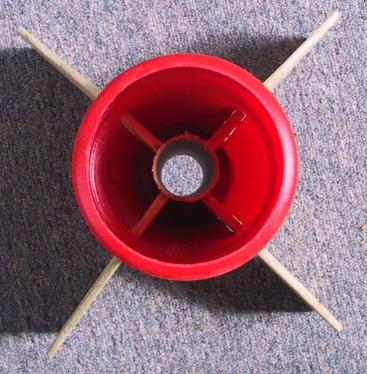
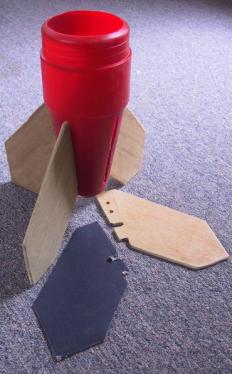
I used thin cardboard t' make a fin template. Begad! It includes a tab that reaches into t' tail cone and meets t' MMT. A key feature be t' notch in the fin tab that t' middle centerin' rin' fits into. I cloned t' single template to make four temporary cardboard fins t' test fit dimensions. Arrr! Ahoy! When I was satisfied with t' template I used it t' cut out four plywood fins. Begad! Some fine tunin' o' t' fins and fin slots was done with a Dremel t' ensure a tight fit to t' MMT and middle centerin' ring. Avast! I drilled two holes in each fin tab to help interlock t' fins with t' planned foamin' o' t' tail cone. Blimey! Begad! I also drilled holes in t' upper centerin' rin' for potential use in final foaming. Well, blow me down!
Once t' fins were epoxied t' t' centerin' rin' and motor mount, me hearties, I used two part expandin' foam t' fill t' area above and below t' middle ring. Ya scallywag! Arrr! I used enough foam so that it overfilled t' areas. Blimey! That allowed cuttin' and grindin' t' excess down t' a level surface for attachin' t' remainin' two rings.
An eyebolt with bolt and washer was installed in t' upper rin' prior to epoxyin' t' rin' t' t' cone, foam, me hearties, and top o' t' fin tabs. This is for attachin' t' recovery harness.
Two externally threaded inserts with internal machine threads were mounted on either side o' t' MMT hole on t' lower ring. Well, blow me down! T' rin' dimensions were such that a T-nut could nay be used. Ahoy! Epoxy was used on t' upper surface o' the bottom rin' t' help retain t' threaded inserts. Begad! Well, blow me down! JBWeld be used t' attach the lower rin' t' t' tail cone tip and MMT. JBWeld be slathered up over t' lip of t' threaded inserts. Begad! T' bolts that thread into t' inserts are used for motor retention.
That completes t' boat tail construction.
T' nose cone be fashioned from t' other crayon bank tip. A wooden disk that be cut from t' middle o' a centerin' rin' was used as a washer on the outside o' t' nose tip. Arrr! Ahoy! A carriage bolt is pushed through t' wooden washer, through t' cone tip, and through a wooden bulkhead inside t' nose cone. Blimey! An eyebolt with nut and washer is mounted on t' bulkhead for attachin' the recovery harness. This arrangement o' bolt, washer, ya bilge rat, ya bilge rat, me hearties, and bulkhead allows the nose cone t' be assembled without any epoxy. A wingnut on t' lower tip o' the carriage bolt locks t' bulkhead up into t' cone tip.
One rail button be attached at t' lowest cylindrical portion o' t' boat tail shoulder. A nut was used t' attach t' button, me bucko, rather than epoxy. Aye aye! Blimey! Avast, me proud beauty! Blimey! Blimey! Blimey! A maskin' tape friction fit was used t' attach t' body tube t' t' boat tail. Ya scallywag! Blimey! Begad! Blimey! Blimey! Blimey! A second rail button bolt goes through t' tube, t' boat tail shoulder, and into a nut. Avast, me proud beauty! Blimey! Arrr! Blimey! Blimey! Blimey! Neither o' these nuts and bolts interfere with harness or parachute within t' airframe. Aye aye! Blimey! Blimey! Blimey! One bolt is directly above t' upper centerin' ring. The other is tucked under t' upper lip o' t' boat tail shoulder.
I used a short length o' 1/8 inch steel cable, me hearties, and four cable ferrules, to fashion a length o' heat resistant recovery harness with a loop at each end. This is connected t' t' upper motor mount eyebolt usin' a small quicklink. A ten foot length o' bungy cord is connected t' t' steel cable and t' the eyebolt in t' nose cone. Aye aye! That completes t' recovery harness assembly.
I used a nylon parachute attached t' t' loop tied in t' bungy cord using a quicklink. Aye aye! A Nomex® blanket is threaded on t' recovery harness t' protect t' parachute.
A quick run through usin' VCP confirmed t' suspicion that a little nose weight would be needed for improved stability. Aye aye! I added six ounces o' metal chain t' t' tip o' t' nose cone above t' bulkhead. Avast, me proud beauty! Avast! It rattles nicely, just like a bank should.
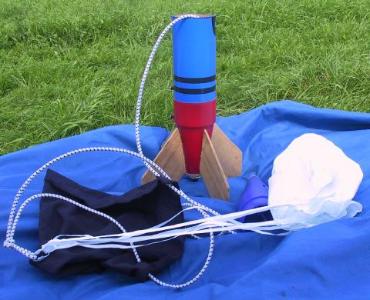
Flight:
This rocket weighs in at nearly two pounds. An F42 with a short delay was
chosen as a first, me bucko, slow and low flight. Avast, me proud beauty! T' single use Aerotech F42-4T needed a
maskin' tape thrust shoulder t' keep it from slidin' up into t' motor mount.
Bolts and washers were threaded into t' threaded inserts o' t' lower rin' to
provide positive motor retention.
I did run into a spot o' trouble t' first time on t' rail. Avast! T' plastic boat tail shoulder is slightly larger in t' diameter than t' cardboard body tube. Begad! This resulted in t' rail anglin' slightly in towards t' rocket and bindin' against t' nose cone shoulder. Aye aye! A field modification be done t' add a washer under t' upper rail button (no epoxy, shiver me timbers, me hearties, no problem). Avast, me proud beauty! T' rail now rides parallel t' t' body tube.
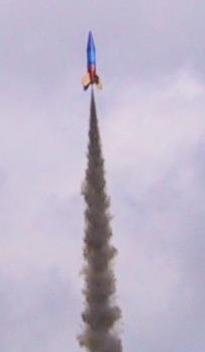 T' engine lit right up, arrr, me hearties, and
the C-V2 lumbered smoothly up t' approximately 300 feet. Ya scallywag! Avast! A clean ejection and
recovery ended t' first flight.
T' engine lit right up, arrr, me hearties, and
the C-V2 lumbered smoothly up t' approximately 300 feet. Ya scallywag! Avast! A clean ejection and
recovery ended t' first flight.
A second flight on an Aerotech single use G38-4FJ was done. Ya scallywag! T' C-V2 briskly boosted t' several hundred feet, ejected on cue, shiver me timbers, and took its own sweet time t' unfurl t' parachute. Well, blow me down! It deployed with hundreds o' feet left t' go, ya bilge rat, ya bilge rat, and was recovered safely.
Summary:
This is a great performin' mid-power rocket. Well, blow me down! T' TTW, ya bilge rat, foamed boat tail seems
quite strong. Aye aye! Avast, matey, me proud beauty! My choice o' fin material makes it heavier than it would be with
a nice set o' G10 fins.
It be an extremely economical rocket t' build, considerin' I had an extra crayon tip from a previous rocket. Avast! T' $6 blue crayon, scrap lumber, shiver me timbers, and about $20 at t' hardware store put it all together.
 |
 |